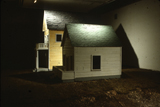From the Outskirts to the Center
| Rita McKeough continues to enthrall and provoke. At her fall 2003 installation at the Owens Art Gallery in Sackville, New Brunswick, one is surprised by incongruity, by a cacophony of sound and motion. Grasping at a hefty moving vehicle, a white-haired woman is dragged across the floor. Her body askew, clad in thick layers of black motorcycle gear, she hauls in vain at a large motorized vehicle as it careens relentlessly from wall to wall.Performance art persists as an activity reserved for the brave. The body exposed is a testament to commitment and courage. McKeough investigates feminism, marginalization, and environmental concerns. As in her previous work, we are led towards estrangement as a concept or as an attitude, estrangement vis a vis the female experience, or towards western society ’s debasement of nature and heritage. By the same token, however, her critique implies – in the space of silence after experiencing her noisy environment – its antithesis, where the particularities of animals, their cries, howls and utterances together with the realm of nature are honoured.
McKeough spends 17 full consecutive days, with only one day off – as a performer in Outskirts. A test of strength and endurance, a kind of repetitive dance of sorts – Rita is dragged, gathers up, collects, climbs a ladder, speaks easily and naturally to visitors. Other dramas, large and small, unfold in the installation. The space is partitioned into multiple simultaneous occurrences, all of them competing for attention. A long wall is clad in a giant print of a contrived forest. Cardboard tubes substitute as trees, indexing their papery origins. The space is livid with sound: cars honk, trains signal insistingly, the human voice in some adagio laments, gears and mechanisms abound. The artist enacts distinct, ritualized activities. Picking them up from the ground, she collects cigarette butts , and from the top of a ladder tosses the butts into the “tube-trees” which then spit the butts out onto the floor. She seems to be assisting the trees as they filter of our dirty air, absorbing and recycling the pollutants that we exhale. In patient gestures of care and futility, she engages with the impulse to tend, to tidy and to clean up. Apparently necessary, the repetitive process fails to yield discernible results. |
 |
